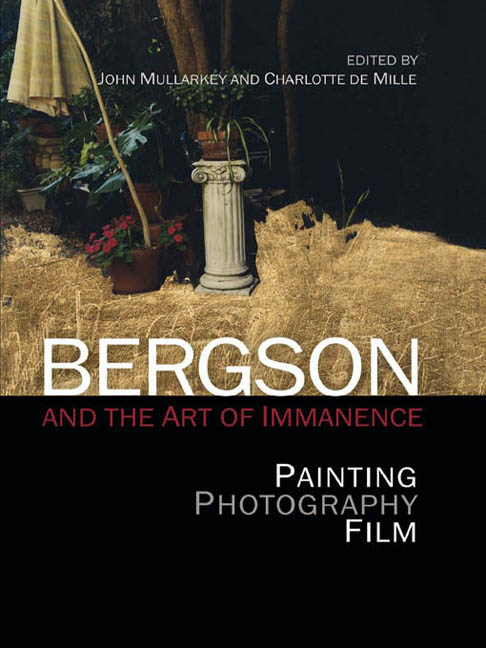Book contents
- Frontmatter
- Contents
- List of Illustrations
- Notes on Contributors
- Introduction: Art's Philosophy – Bergson and Immanence
- Part I Bergson, Art, History
- Part II Unconditional Practice
- Part III Immanence of the Visible
- 11 Painting the Invisible: Time, Matter and the Image in Bergson and Michel Henry
- 12 ‘For We Will Have Shown it Nothing’: Bergson as Non-Philosopher (of) Art
- 13 The Untimeliness of Bergson's Metaphysics: Reading Diffractively
- 14 Hyperaesthesia and the Virtual
- Afterword: An Art Historical Return to Bergson
- Index
14 - Hyperaesthesia and the Virtual
from Part III - Immanence of the Visible
Published online by Cambridge University Press: 07 December 2017
- Frontmatter
- Contents
- List of Illustrations
- Notes on Contributors
- Introduction: Art's Philosophy – Bergson and Immanence
- Part I Bergson, Art, History
- Part II Unconditional Practice
- Part III Immanence of the Visible
- 11 Painting the Invisible: Time, Matter and the Image in Bergson and Michel Henry
- 12 ‘For We Will Have Shown it Nothing’: Bergson as Non-Philosopher (of) Art
- 13 The Untimeliness of Bergson's Metaphysics: Reading Diffractively
- 14 Hyperaesthesia and the Virtual
- Afterword: An Art Historical Return to Bergson
- Index
Summary
… we perceive virtually many more things than we perceive actually, and that here again the role of our body is to separate from consciousness all of that which we sense to be of no practical interest, all that which does not lend itself to our action. (Bergson, ‘Fantomes de vivants’)
Bergson's conviction that we perceive much more than our consciousness allows us to perceive is central to his understanding of the virtual. This enigmatic part played by the virtual in Bergson's theory of perception receives its compelling quality from the confluence of a philosophical interest in Leibniz's monadology and its theory of petits perceptions, with a parapsychological inquiry into the phenomenon of ‘hyperaesthesia’ or states of extreme perception. The latter are characterised by a high intensity of perception – mainly but not exclusively visual perception – that becomes manifest in pathological contexts where conciousness and the habits of daily life are suspended. Already at Clermont-Ferrand in the 1880s Bergson's teaching of Leibniz allowed him to situate the hyperaesthesia he encountered in his experiments with hypnotism within a broader theory of perception which was at the same time confirmed by his experiments. Leibniz's theory of petits perceptions and the experimental encounter with hyperaesthetic states allowed Bergson to frame the argument – altogether at odds with the Cartesian tradition – that conscious perception is above all the outcome of limitation. The conviction that consciousness entailed limitation led Bergson to pursue a theory of expanded perception, framed temporally in terms of durée in Time and Free Will but thereafter consistently in terms of hyperaesthesia and the virtual.
The relation between hyperaesthesis and the virtual points to a different understanding of Bergson's theory of perception than that which has largely prevailed in interpretations of his work. It can, for example, be distinguished from Deleuze's influential understanding of intuition as method in Bergsonism, a method that impels ‘us to go beyond the state of experience towards the conditions of experience’.
- Type
- Chapter
- Information
- Bergson and the Art of ImmanencePainting, Photography, Film, Performance, pp. 247 - 259Publisher: Edinburgh University PressPrint publication year: 2013

